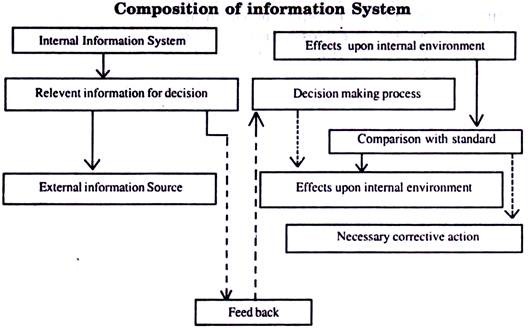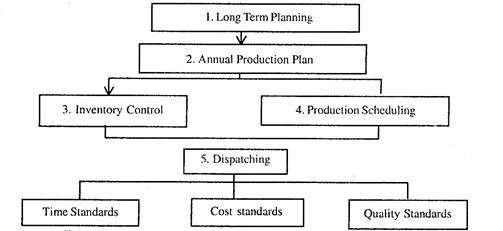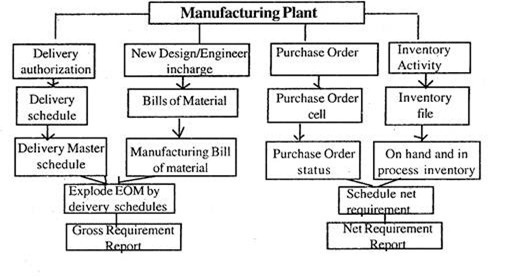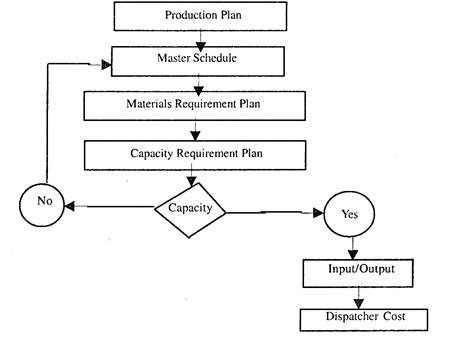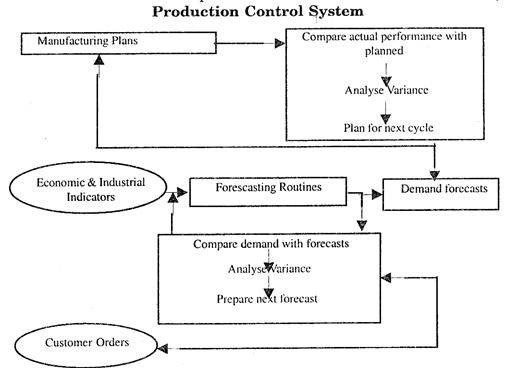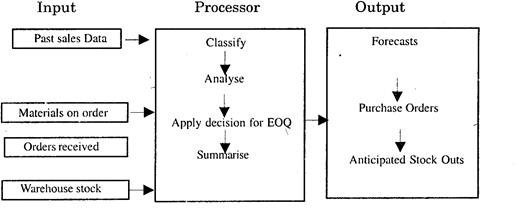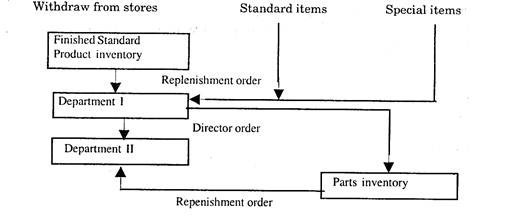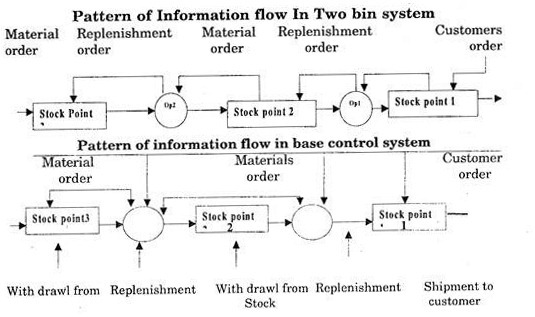Here is an essay on ‘Production Information System’ for class 11 and 12. Find paragraphs, long and short essays on ‘Production Information System’ especially written for school and management students.
Essay on Production Information System
Essay Contents:
- Essay on the Fundamentals of Production, Information and System
- Essay on Production Information System
- Essay on Production Planning and Control Information System
- Essay on Production Planning System
- Essay on Production Control System
- Essay on Materials Management Information Systems
Essay # 1. Fundamentals of Production, Information and System:
ADVERTISEMENTS:
A. Production:
Production is some process through which goods and services are created. Production/Operations is the heart for an organisation and add value to some object enhancing its usefulness. This is done by bringing men, machines and materials together as inputs to get the desired output.
In modern times the formulation of production strategy has become a complicated and difficult activity. In one man organisation/enterprise, like retail shops, owner can himself formulate operational plans, review the progress and can make modifications in his plans and method of work.
There is no communication problem as he can effectively communicate with himself to know the present state of activities in his organisation.
ADVERTISEMENTS:
But with evolution of large corporations, due to concepts of division of labour, introduced communication and co-ordination problems. The employees in these organisations perform non- interchangeable functions specializing in their own job, which is isolated from other jobs in the organisation.
The various departments in the organisation are created on a functional basis to secure income through sales and production, to control the flow of capital and to ensure the continuation of the process at a profit. The important functional groups are marketing, production, engineering, finance and personnel.
The production department performs the function of transferring input into some desired output. In other words, the role of production department is to manufacture the company’s products in accordance with quality specifications and to produce goods at minimum cost. The production department performs a number of operations/activities carried out by a number of sections.
Each section performs some specialised activity and tries to optimize its level of performance. The common denominator related to the various activities of these sections of any type of production system is the flow of materials. A production organisation is characterised by the nature of inputs, transformation process and the output.
B. Information:
‘Information is the glue that holds organisations together’. It has become an important input in all walks of life today. Information is data that is processed in a form, which helps the management to take decisions. The value of information is associated with decision-making and can be considered at a higher and active level than data.
If there were no choices/decisions information would be unnecessary. Information is alive as it is required to be updated all the time and is renewable. It can be easily expandable. Substitutable and transportable.
The problem related with information is mainly of communication and can be classified in the following categories:
C. System:
System is an abstract/physical set of elements, which operate together to accomplish an objective. A system may be defined as ‘a purposeful collection of people, objects and procedures for operating within an environment. It is composed of interacting components operating under human control. Webster defines system as “a set/ arrangement of things so related or connected to form a unity of organisation“. Every organisation can be visualised as a system comprising of various departments/sections as sub-systems.
D. Production System:
Using the generalized concept of production as a basic process which converts the resource inputs into some useful form of outputs. We can term the various components of the production process as a system. Inputs to the System may be labour, material, equipment, facilities, information etc. The output may be in terms of finished products or services. The conversion process is some combination of men, machines, equipment, material and other facilities performing various operational activities in some pre-designed order/ sequence.
ADVERTISEMENTS:
E. Information System:
The system objective should be clearly stated in terms of the functions it is to perform i.e. what managers can do and how effectively they would be able to function after their information requirements have been met e.g. objective of system may be to optimise the production by identifying the variance so that these could be closely monitored.
An information system matches for significant events to happen and triggers an intelligent response in all sections of the system to a significant development in any part. It is not merely a communicating network but also generates intelligent response. It has a methodology of decision models built in it and is available to alternative.
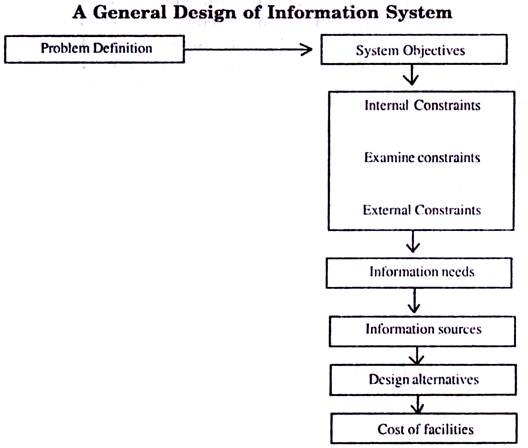 The design of information system in fact starts with identification of the information needs of the users. Manager needs specific elements of information pertaining to the parameters that influence his decisions and the decision methodology for optimum decisions. These parameters are defined by the problem description.
The design of information system in fact starts with identification of the information needs of the users. Manager needs specific elements of information pertaining to the parameters that influence his decisions and the decision methodology for optimum decisions. These parameters are defined by the problem description.
The organized flow of relevant information and the decision methodology needed for a specific decision has to be built into the information system. The responsibility of the information system is just to observe. Classify and store any item/data, which might be potentially useful to the decision maker.
ADVERTISEMENTS:
An Alternative View of Information System:
An information system is designed in a number of small modules. Some modules are used only once while others might be used in a large number of applications. The use of common modules considerably reduces the programming and designing effort in an information system e.g. Sales forecast system can cater the needs for marketing, production and inventory operations.
There are three important components in any information system for decision making viz.:
ADVERTISEMENTS:
i. Inputs,
ii. Processing and
iii. Output.
The detailed composition of any information system can be explained with the help of following chart:
Composition of Information System can be explained with the help of following chart:
The aim of information system is to improve decision, lower costs, strengthen operation control, meeting customer demand and improving the image of the organisation.
ADVERTISEMENTS:
Essay # 2. Production Information System:
ADVERTISEMENTS:
Production information system performs an integrating role with in the production system of any organisation. Management of activities/operations in a production system is concerned with decision making related to different components of the system so as to accomplish the desired output.
These decisions can be divided as periodic-decisions viz. selection, design and updating of resources, transformation process and methods, and continual decisions about day-to-day operation and control of various activities/operations in the system. These decisions can also be divided in planning, implementation and control categories.
Production information system is a network to generate necessary information and process it to make various decisions related to some production system. It consists of communication channels and information processing centres collecting information from its sources of origin, storing, updating, collating and processing it and then supplying the processed information to the various users of the system.
ADVERTISEMENTS:
A production information system can be viewed as an independent group of sub-systems each related to its successor, each performing a different function though yet united with others for achievement of the overall objective. It interacts with both its internal and external environments.
The components of the system can be described as:
1. Long Term Planning:
This implies planning the conversion system specifying the sequence of operations, capacity of the system, plant location and its layout aspects. The decisions derived have long term impact and are difficult to undo once implemented. Information for taking such decisions is compiled periodically for determination of appropriate product mix.
2. Annual Production Plan:
ADVERTISEMENTS:
These are meant to plan the use of transformation process. These plans are drawn from sales programmes by optimizing inventory-carrying costs, costs on labour with hiring and firing of personnel etc. These plans are revised periodically.
3. Inventory Control:
It is generally expressed in terms of money and number of units produced. It deals with preparation of master inventory and production schedules.
4. Production Scheduling:
These decisions are to determine: what to make, when to make, how to make, how much time is required to make it, production plan, bill of materials and operations sheets providing the necessary information for the preparation of production schedules.
5. Dispatching:
ADVERTISEMENTS:
Time standards are formulated through operation/route sheets supplied by planning and engineering departments. Cost standards are calculated through cost cards and job tickets and the quality standards are prescribed by design & engineering sections.
Thus production information system is a matter of planning and generating records for decision-making.
MacNeice has subdivided these records into three types:
A. Records of Basic Information:
(i) Blue Prints,
(ii) Bill of materials,
ADVERTISEMENTS:
(iii) Time value of fundamental operations and
(iv) Production routing.
B. Records showing what is available:
(i) Raw material records,
(ii) Work in process,
(iii) Semi-processed stock,
(iv) Finished goods stock,
(v) Information about tools, jigs, fixtures, gauges and personnel available,
(vi) Machinery and equipment details
C. Historical Records:
(i) Records of production,
(ii) Records of waste and reject,
(iii) Records of machine performance,
(iv) Records of sales and
(v) Records of absenteeism.
The nature of these records can vary for different type of plants and production systems as well as according to the situation and needs of the management. In a small organisation the preparation and maintenance of these records is the job of shop floor.
But it becomes an important function in medium and large scale organisations having separate section for collection and preservation of such records. Usually this Work is done by dispatchers who continually observe the actual implementation and compare it with the programme previously intimated.
Characteristics of Production Information System:
1. It should always be tailored to the need of a particular organisation. It can never be specific or general.
2. The involvement of top management in the formulation of production information system is essential.
3. Data base should be wide.
4. It must be flexible and should be supplied timely.
5. Data should be capable of easy interpretation & presentation.
6. The cost of procuring the information must not over-ride the relative advantage accrued.
In production system most of the information needs are in the area of:
(i) Production, Planning and Control,
(ii) Materials management viz. purchase, stores and inventory Control etc. with an objective to optimise production by identifying the variances so that these could be closely monitored.
Essay # 3. Production Planning and Control Information System
:
The designing of an effective production planning and control information system for a given plant requires a clear comprehension of the nature of the manufacturing problem and an understanding of the planning and manufacture of standard products. For designing effective production planning and control Procedures a materials and tools records and Control system must be derived and machine capacity data must be compiled.
Information needs for PPC System are:
(i) Full details of forecasted sales by product and actual sales. This will provide necessary inputs to the production managers to modify their plans as and when required. Such data is useful in managing the problem of under and over production,
(ii) The availability on a daily basis of productive resources viz. space, man-hours and machine capacity. This will provide details regarding the overtime, working, additional shift arrangement and any sub-contracting facility if and when needed,
(iii) Data relating to materials stock, the availability of supplies and the leads times needed for deliveries into the system and distribution from the system,
(iv) Knowledge of company policy relating to work in progress and buffer stock levels,
(v) Details of the factory organisation, layout and maintenance facilities available,
(vi) Human factors which might affect the operation of the plan e.g. absenteeism and industrial unrest if any,
(vii) Feed-back information relating to actual production.
Essay # 4. Production Planning System:
Information needs for production planning are:
(i) Sales forecasts,
(ii) Customer orders.
(iii) Capacity plans,
(iv) Inventory information,
(v) Current information on shop load and lead times.
These elements of information are needed for the development of master schedules for production.
The flow of information for production planning can be explained by the following chart:
Information System for Scheduling:
Planners generally carry out scheduling in three steps:
(i) They establish job priorities and completion dates of orders i.e. they schedule an order in relation to other orders. This involves Master Scheduling.
(ii) They schedule within an order.
(iii) They establish the order of work for machine loading and for fixing the beginning and ending dates of operations on equipment. The second and third steps are done through production scheduling.
Master Schedule System:
In master scheduling planners balance the production requirements (based on customers’ orders received and a forecast of new sales orders) against the available plant capacity and establish approximate completion dates for customer’s orders.
Master schedule is the first step towards production planning. It authorises planning sections to make detailed plans for the availability of materials and utilisation of plant capacity with the aim of maximum economy to the company.
The placing of an order in a given priority class establishes the relative importance of the order as compared to other order received and sometimes as compared to work already scheduled but not yet processed.
For most repetitive manufacturing systems the master schedule is a comparatively simple form showing the quantities of each type of product to be made in a given period. Here the information about the output capacity and time required for the production cycle is drawn from past experience.
Production Scheduling System:
Production scheduling details first require, scheduling within an order so as to reduce the overall processing time, to speed the turn-over of work in process and to minimise the strategic and misplacement of completed parts by deferring their production until they are needed. Scheduling within an order may include the setting of successive beginning times for engineering of products, tooling up and processing materials.
Scheduling the order of work for machine loading fixes calendar dates for beginning and ending of operations on plant equipment. The priority rating of an order work schedule. In a repetitive manufacturing concern production scheduling is largely a matter of increasing or diminishing the rate of output for parts and assemblies to conform with the master schedule.
A. External Factors:
Consumer demand, customers delivery date, dealer and retailer inventories, lead time for procurement, transit time, cost of not meeting demand or delivery date.
B. Internal Factors:
Finished goods inventories, lead time of starting production, number of operations and time of each operation, flow time, availability of equipment, personnel, material, economic production run, cost of in-process material, cost of carrying inventories, cost of increasing production capacity and cost of reducing process interval.
Updating and Review of Planning Decisions:
The process of planning in any production system involves certain external and internal environments the dynamic nature of these environments makes our planning decision obsolete/irrelevant. Thus there is a continual need of updating the information related to environmental parameters and then reviewing the decisions already taken to make modifications if necessary.
Essay # 5. Production Control System:
Production control is the function of planning and controlling the production cycle to assure that facilities and the personnel are economically utilised and that products are manufactured within time and cost limits. Production control is responsible for ensuring timely availability of all the pre-requisites of production viz. drawings, operation layouts, special tools, jigs and fixtures, raw materials and bought outs.
The complexity of present day business is more prominent in the production control system, where the number of decisions may literally run to hundreds or even thousands a day. The fact is that situations recur and most decisions are based on considerations similar to the one encountered in the past. Systems approach enables to establish the decision rules such that repetitive situations can be handled routinely.
Control of job-order production is achieved by periodic checking and following up the progress of orders to assure that the work is being done on schedule. A column “actual completion date” on route sheets or on schedule sheets may be used for this purpose.
The dispatchers record the progress of work by observing the times and dates when work is completed and by making the appropriate notations on route sheets or schedule sheets. The planning office maintains a check on progress by receiving daily reports from dispatchers.
In repetitive manufacturing system the control function becomes operative with the release of orders that set plans into motion. The plans establish flow rates for synchronized output of required parts for assembly.
The aim of control is to maintain the scheduled rate of output, which is sufficient to satisfy demand, and also keeps inventories of parts, raw materials and finished goods at a practical minimum. Planners compare actual with planned output and take prompt corrective action to rectify deviations.
Control charts can be used to control production of finished goods. Weekly or daily reports on the amount of finished units produced are plotted against scheduled output. Control charts for key parts and sub-assemblies can show whether the rates of output for components and sub-assemblies are sufficiently synchronized and in balance.
A control chart for all items in production can provide a comprehensive picture of a plant output performance.
Production control system needs following information:
(i) Periodic information about sales forecasts, which are divided into requirement quotas.
(ii) Upto date bills of materials specifying product models and name, part numbers and their arrangement into sub-assemblies and assemblies, materials specifications and requirements. Production control then prepares a master schedule of material requirements that are based on the demand forecasts and bills of materials.
(iii) Production control should prepare a master load schedule through which top management can appraise plant capacity in terms of the production required by the sales forecast and break bottleneck, if any.
Essay # 6. Materials Management Information Systems:
The economic working of business enterprises requires that the available capital resources are used most judiciously. Material costs usually account for well over 50% of the investment in the enterprise. Thus attempt to organize information in materials management viz. purchase, processing, storage and production can help in conserving on the outlay of capital investment on materials i.e. at least by 5% reduction in material costs.
In this case the information system must meet needs of the total material planning within the company e.g. to determine the Economic Order Quantity for purchase monitoring buyers performance, vendor analysis, forecast future needs for ordering materials and to prepare exception report. The system has to cater the needs of material for purchasing department, production objectives and capacity planning.
Objectives of integrated approach in materials management can be:
(i) To minimise investment in inventories.
(ii) To provide material of a specified quality at the lower cost.
(iii) To perform functions of material handling and storage so that storage costs are minimised.
(iv) To cut through standardisation. Value analysis, waste control and import substitution.
(v) To improve procedures and to delegate authority and responsibility at various levels of materials management.
(vi) Materials waste must be minimised if not eliminated.
An integrated approach to materials management must look at all the above problem areas in a co-ordinated manner.
The information needs for purchase management can be:
A. For Planning Purchases:
(i) Details of items to be purchased with specifications.
(ii) Possible sources of supply.
(iii) Prices
(iv) Delivery time.
(v) Reliability with past performance.
B. For Controlling Purchase:
(i) Orders to be placed
(ii) Orders actually placed
(iii) Delay in placing orders
(iv) Materials expected to be received
(v) Materials actually received
(vi) Delay in receipt of material and
(vii) Problems and actions.
The information system for purchase management can be:
The information needs for store management can be:
(i) Stock categories, classification and codification.
(ii) Movable and non-movable items.
(iii) ABC categories
(iv) Past consumption.
(v) Maximum and minimum levels.
(vi) Re-order point and re-order quantity.
(vii) Cycle time consumption
(viii) Lead time consumption.
Stores control can be done by analysing:
(i) Actual stock vs. permitted levels.
(ii) Overstocking and stock outs.
(iii) Actual and anticipated stocks.
(iv) Problems and actions.
The design of stores control information system can be:
Information needs for inventory system are:
(i) Details of sales forecasting, production planning and purchase policy.
(ii) Data on actual orders received, production output and variations in the expected pattern of supplies to the organization.
In inventory systems the flow of information depends on the nature of the system i.e. Two-Bin system or Base stock control system.
Here as the customer’s order is received the facts of the order are reported back to each operation processing the item. Then at each operation a batch is raised from time to time on any of FOO, FOC or S/s systems.
The salient features of the base stock control system are:
(i) Each stock point acts directly against the customer demand.
(ii) Reporting of customer demand is separated from the replenishment action.
(iii) Base stock = maximum customer demand during the supplying operation lead-time + standard order quantity at each stock point.
(iv) Replenishment of a stock point is initiated by the supplying operation on the basis of customer demand
In a business organisation manufacturing products, the production planning and control department assumes the major responsibility. Its role and functions are to see that the production order meet the marketing requirements and that the production cost for each product are kept minimum by properly scheduling the arrivals of materials as required at various phases of the production process. Usually the production manager in charge of production, planning and control also controls purchase and stores department.


